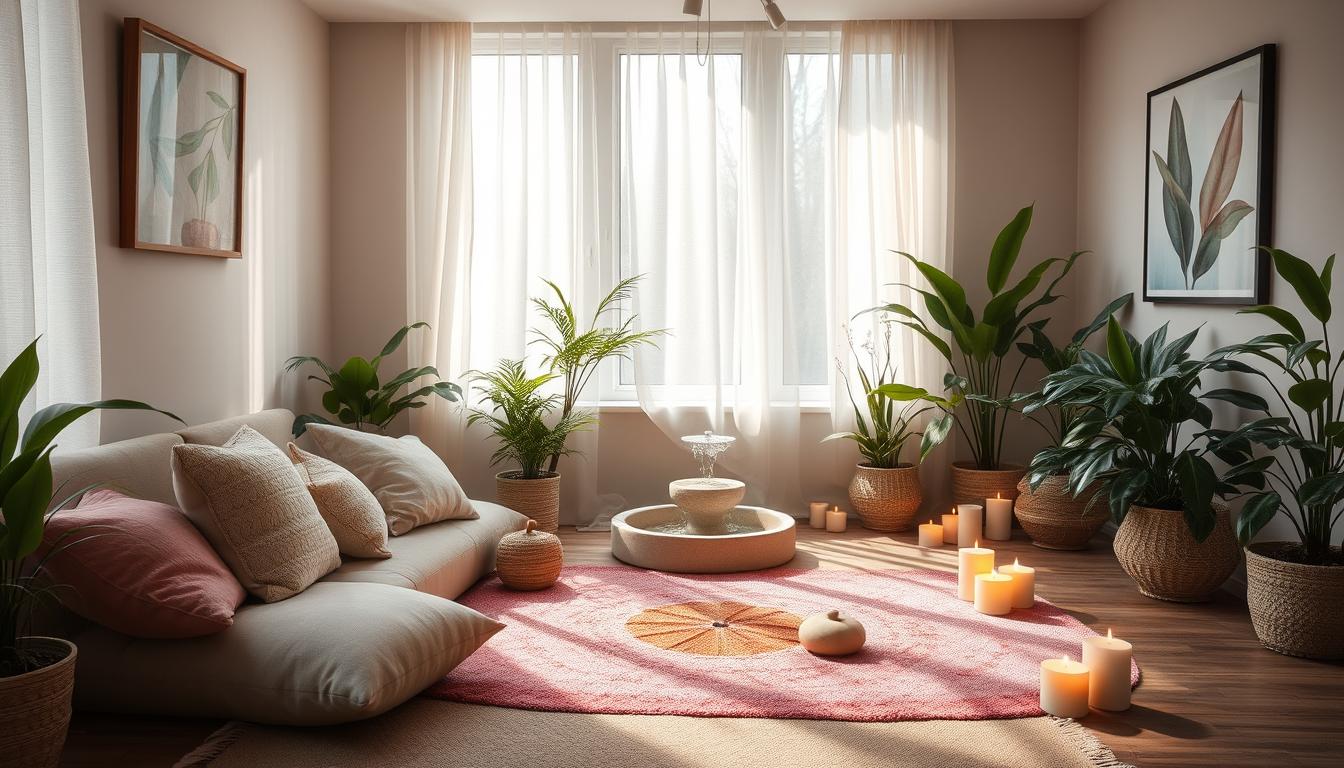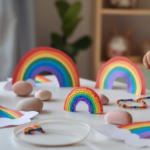When Mary walked into her kitchen, her eyes sparkled with recognition. At the age of 78, baking wasn’t just a pastime, but a deeply loved routine she had with her late husband. Her hands, although a bit shaky with age, moved gracefully as she kneaded dough.
The process of kneading offered her moments of peace and a feeling of continuity, even as she faced the early stages of dementia. Her story shows how important sensory activities are. They truly help with the mental and emotional well-being of seniors and adults.
Many seniors with dementia, about 65%, often feel anxious, upset, or angry. Sensory activities can help lessen these feelings. Research tells us that these activities can cut down anxiety by up to 60%. This brings a nurturing calmness. And 85% of caregivers see seniors’ moods improve when these activities are part of their care. Activities like knitting or making scent boxes stimulate the senses. They also give a sense of accomplishment.
Caregivers often feel a lot of stress, with 71% saying their job really weighs on them. But by adding sensory activities, both the seniors and caregivers benefit. These activities make their time together more positive and less stressful. Just picture the happiness on a senior’s face when a familiar smell triggers a beloved memory. Or the peace they feel sorting things they know well. Sensory activities create these special moments, making them vital in caring for seniors and adults.
Key Takeaways
- Sensory activities can reduce anxiety levels by up to 60% in seniors with cognitive impairments.
- 85% of caregivers report improved mood in seniors during home care visits.
- Engaging in sensory activities leads to a 50% increase in positive engagement compared to traditional activities.
- Activities involving smell and touch can increase memory recall events by 25% for seniors with cognitive impairments.
- Simple sensory activities help keep busy hands occupied, decreasing anxiety levels.
Introduction to Sensory Activities for Adults and Seniors
Sensory activities aren’t just fun. They’re key for keeping the mind sharp, especially for those with dementia or Alzheimer’s. These activities help bring out positive feelings, which are important for happiness and health.
About 40 million adults in the U.S. face anxiety disorders each year. Sadly, only 36.9% of them get the help they need. This highlights the need for sensory activities. They’re good for lessening anxiety and boosting mental health.
Sensory-friendly activities tap into our senses – touch, smell, sight, hearing, and taste. They offer comfort and stimulation. For example, we have over 20 types of receptors for touch. They send messages to our brain that can calm us or help us focus. Stress relief toys, like fidget spinners, have helped 1 in 5 adults.
The market for stress relief toys is growing. It might go up nearly 3% each year until 2024. These toys are recognized for their benefits more and more. They can improve mood and behavior, make you more alert, and boost communication in people with dementia. Since 5 million Americans have dementia, and caring for them is costly, these activities are vital.
Sensory therapy can also handle tough dementia symptoms, like wandering or agitation. Things like heavy work help with focus by providing input to muscles and joints.
To sum up, sensory activities help adults and seniors in many ways. They improve brain function, emotions, and life quality. Caregivers and health workers can make a big difference by using these activities.
Why Sensory Activities are Important
Sensory activities are key for the well-being of adults and seniors, especially those with cognitive issues. Sensory integration activities help people keep their skills and feel better in mood and behavior. A review of 30 academic papers from the last 15 years shows sensory activities help a lot in dementia care.
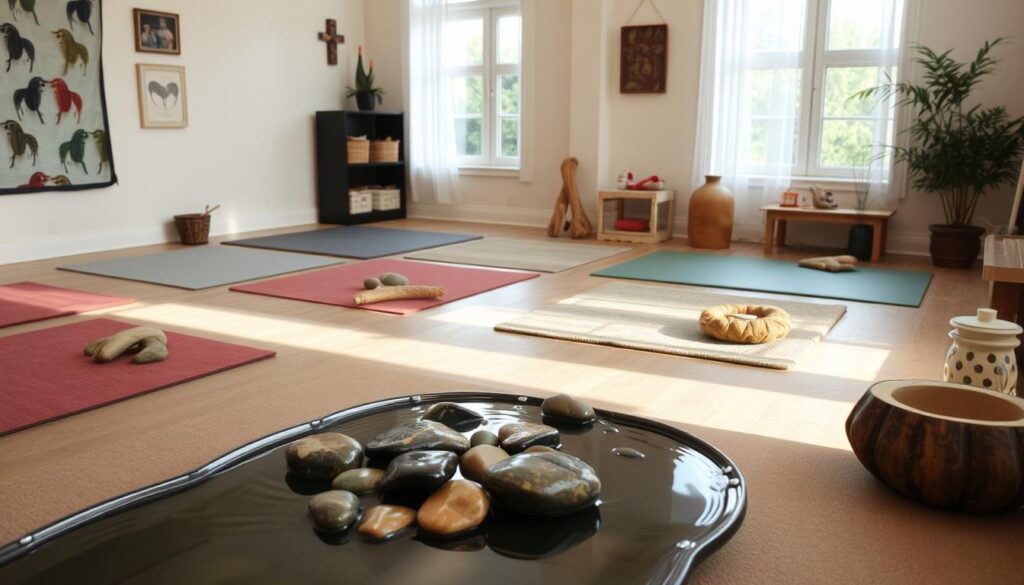
The study found that 60% of the themes showed sensory activities are useful, especially in care facilities. The reports noticed big improvements in communication, life quality, and overall function. A good 71.2% saw positive changes. Also, 18.2% talked about the need for care focused on the person, while 10.6% noted some sensory therapies are easy to start.
Sensory activities can help without needing drugs, which is great because some medicines have only a little effect and are used too much. These activities are a better choice. With more elderly people around the world, promoting sensory activities is more important than ever.
The link between less sensory ability and lower life quality in older people is clear. Sensory activities help their physical, mental, emotional, and social health. This meets their needs well, giving them a better life than just living longer.
Studies show that sensory activities help those with dementia communicate and show who they are without needing words. Activities like baking or crafting reduce upset feelings and make moods better. The value of sensory activities in caring for people with ASD or dementia is still a key area of research, showing how important they are for improving lives.
Using Baking as a Therapeutic Sensory Activity
Baking is a great way to explore the senses. It involves touch, smell, sight, and taste. Mental health pros, like Tracy Thomas, Ph.D., bake once a week as self-care. It’s a calming activity that helps adults and seniors feel better.
Benefits of Baking
Baking is more than making yummy treats. It makes you more aware of your body and mind. Kneading dough and mixing batter require focus, recommended for sensory activities. Nicole Beurkens, Ph.D., says these are calming and cut down stress.
When you bake, you often remember happy times. This can release happy chemicals in your brain. For kids needing sensory activities, like those with autism, baking is great. It helps them learn and chill out at the same time.
“Flow” is key for feeling connected to yourself, says Tracy Thomas. Cooking and baking put you in this state. You feel fully involved and proud of what you make.
Creating a Safe and Fun Baking Environment
To get the most from baking, make it safe and fun. Use easy instructions and get rid of dangers. This is super important for safe sensory activities, especially with autism. Tools that help everyone take part are a good choice.
Having a clear start and finish helps everyone feel in control. This can ease sadness and stress. Trying and sharing your treats makes baking fun and uplifting.
So, baking with adults and seniors is not just fun. It’s also good for emotional and mental health.
Baking for Seniors with Dementia
Baking offers a multisensory experience that engages touch, smell, and taste for seniors with dementia. It can be a safe, enjoyable activity with the right modifications. It suits both preschool special needs and senior sensory activities.

Baking with Early Stage Dementia
Early-stage dementia seniors find familiar tasks like baking beneficial. Measuring, mixing, and shaping dough helps maintain their skills. Adding favorite smells like vanilla or cinnamon can bring back happy memories and boost their senses. It gives them a sense of purpose and achievement.
Adapting Recipes for Safety
Making the kitchen safe is key for senior bakers. Use sturdy, unbreakable bowls and keep sharp tools away. Choose simple recipes like No-Bake Cookies or Fruit Salad. This ensures everyone can join in, staying happy and stress-free.
About 69% of early dementia sufferers struggle with kitchen tasks. Tailored activities like baking improve their skills and self-worth. In care homes, it can lessen upset feelings and increase life quality.
Baking meets both the sensory and cognitive needs of dementia seniors. It’s an important part of activities for them and for special needs preschoolers.
Folding Towels as a Calming Activity
Many adults and seniors find calming activities very helpful. Folding towels is a simple yet effective activity. It helps people feel accomplished and calm, especially beneficial for seniors with dementia, by using repetitive motions and touching different textures.

Studies have found that sensory therapy reduces anxiety in dementia patients. The act of folding towels boosts hand dexterity and provides a comforting experience. Touching various fabrics helps seniors calm down and lower their anxiety levels.
Folding towels is an easy activity that promotes independence and productivity in older adults. It helps with coordination and balance, which improves physical health. For those with early-stage dementia, trying more complex folds can help, while keeping it simple benefits those in advanced stages.
Adding calming sensory activities like towel folding to daily routines can boost cognitive functions and memory. These tasks offer comfort and engage the senses, which helps in stimulating memory recall and offers cognitive benefits. They also help reduce irritability and depression, promoting a sense of achievement.
By making towel folding part of their sensory activities, caregivers can help improve the life quality and emotional well-being of adults and seniors. It’s a simple, yet impactful way to support them.
Engaging Seniors with Knitting or Crochet
Knitting and crochet are more than just hobbies. They are key for improving seniors’ well-being. Through their rhythmic and repetitive actions, these activities boost fine motor skills and cognitive function. They also foster a meditative state that reduces stress. Research shows that activities like knitting can slow dementia progression and make life better.
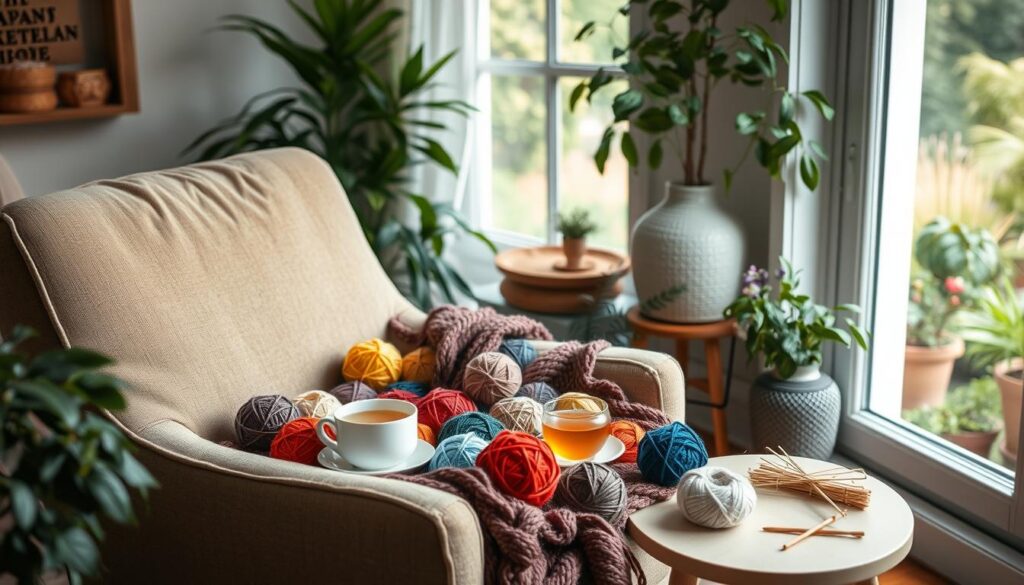
Benefits of Knitting or Crochet
Knitting or crochet bring many benefits to seniors:
- Improved Memory: Knitting regularly can boost memory and problem-solving skills.
- Reduced Anxiety and Depression: It gives a sense of purpose and accomplishment, easing anxiety and depression.
- Enhanced Social Interaction: Knitting groups help seniors feel less isolated by connecting them with others.
- Maintained Dexterity: These crafts support hand-eye coordination and overall dexterity by keeping fine motor skills sharp.
Tips for Adapting Tools and Supplies
To help seniors, especially those with less dexterity, modifications to tools and supplies are key:
- Use Larger Needles: Bigger needles and thicker yarns are easier to use.
- Ergonomic Tools: Ergonomic hooks and needles reduce hand strain, making crafting more enjoyable.
- Adaptive Patterns: Simple patterns can help beginners or those with cognitive issues enjoy crafting without stress.
- Organized Kits: Pre-organized kits make sure all needed supplies are ready and easy to use.
Organizing a Junk Drawer for Cognitive Stimulation
In the world of dementia care, activities that stimulate the senses are key. They help seniors keep their minds sharp and feel better emotionally. Organizing a junk drawer is one such activity that boosts brain power. It helps with making decisions and solving problems, which are important for mental health.
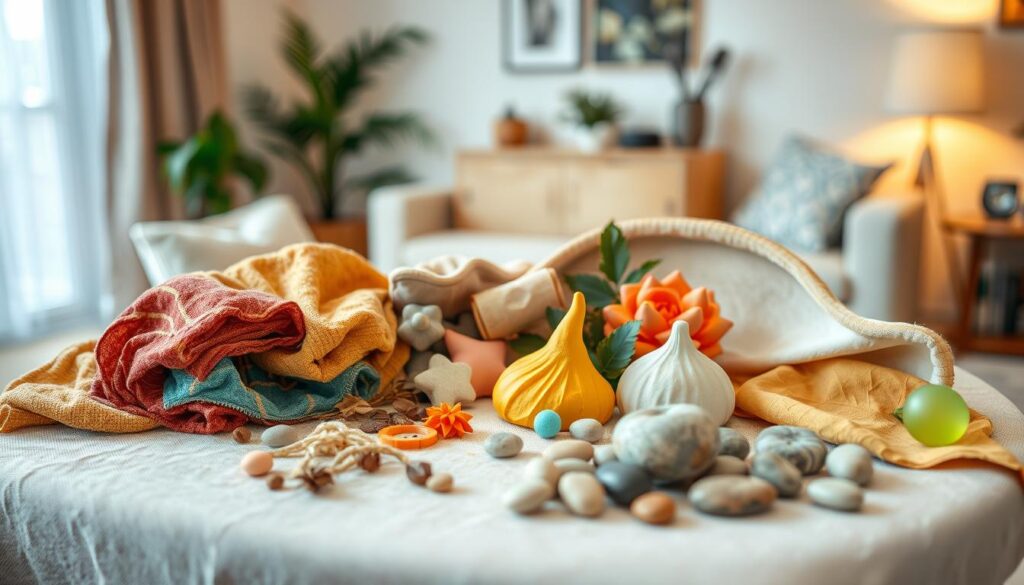
When seniors organize a drawer, they might find things that remind them of good times. Touching objects they remember can make them feel 25% more comfortable and stable. Sorting things also lets them feel more in control, which is great for their mood.
This task is easy and doesn’t make seniors feel stressed. Caregivers notice a 60% jump in how engaged seniors are when they do this. Organizing helps lessen anxiety and sadness, making life better for those with dementia.
Talking about items from the drawer can also help seniors remember the past. This can improve their memory by up to 40%. As they handle different objects, they keep their hands and brains active in a good way.
Doing activities like this often can make a big difference in seniors’ lives. Engaging in familiar, soothing tasks can make them feel 70% happier. So, organizing a junk drawer isn’t just about cleaning. It’s a valuable part of care for people with memory issues, offering mental and emotional perks.
Shuffling and Arranging Cards for Sensory Engagement
Shuffling and arranging cards is a simple, yet impactful, sensory activity for seniors. This activity engages both touch and sight. It can be calming and stimulating at the same time. The rhythmic actions of shuffling and organizing can help the elderly focus. They may also feel a sense of accomplishment.

Simple Card Games for Seniors
Simple card games are great for sensory stimulation for seniors. “Go Fish” deals each player 5 cards, and “Crazy Eights” works for 2 to 8 players. These games are easy to play and adapt for different cognitive levels. They encourage memory, strategy, and social engagement.
Seniors might also like “War,” which is easy and for two players, or “Rummy.” “Rummy” involves 2 to 6 players and mixes strategy with memory skills.
Organized Activities vs. Free Play
Finding the right mix of organized games and free play is key. Organized games boost cognitive stimulation, helping maintain mental function. This is especially important for seniors with conditions like dementia.
Free play, on the other hand, encourages creativity and personal expression. It’s an important part of activities for the elderly. Both methods can be tailored to fit individual needs and preferences. This ensures all seniors can enjoy and benefit from card activities.
“Card games contribute to mental stimulation and cognitive function for seniors, helping to maintain and improve cognitive abilities such as problem-solving, attention span, and mental agility.”
Adding card shuffling, arranging, and playing into a senior’s daily activities is simple but effective. It boosts their well-being through sensory activities and cognitive engagement.
Creating a Fidget Sensory Box
Fidget sensory boxes offer a valuable outlet for individuals seeking to manage stress and anxiety through sensory engagement. They are perfect for sensory activities for dementia patients and tactile sensory activities for adults. These boxes can include a variety of items that stimulate different senses, especially touch, sight, and sound.
Choosing Items for the Box
When creating a fidget sensory box, choosing the right items is crucial. They should provide calming and engaging experiences. Here are some great options:
- Stress balls and squishy gel bead fidget squares: With tiny gel beads, these items offer tactile fun.
- Textured fabrics: Soft fleece and furry sensory squares, sometimes scented with lavender or mint, add soothing touch.
- Deluxe Tangle Therapy: These are twice as thick as standard Tangle toys, enhancing engagement.
- scented sensory cards: These cards keep scents for up to a year, triggering happy memories and feelings.
- Aromatherapy sprays: Available in calming scents like lavender, peppermint, and spice.
- Boinks marble fidgets: They have a marble inside that slides back and forth, stimulating touch.
How to Use the Fidget Box
Using a fidget sensory box daily can help seniors with dementia focus and calm their senses. To get the most from tactile sensory activities for adults, try these tips:
- Establish a Routine: Include the fidget box in daily activities for consistency.
- Encourage Exploration: Let seniors explore the items at their own pace to find what they enjoy.
- Combine with Other Activities: Pair the box with other sensory activities for varied fun.
- Monitor and Adapt: Check which items work best and switch them out to keep things interesting.
Fidget sensory boxes are a simple but effective way to help seniors, especially those with dementia. They offer comfort and lessen anxiety through sensory stimulation.
No-Paint Painting for Visual and Tactile Stimulation
No-paint painting uses water and special canvases to show colors when wet. It’s a great sensory activity for blind adults. This activity is easy but gives great results, perfect for therapy. It’s clean and gives both sight and touch stimulation.
This kind of painting is great for seniors, especially those who struggle with regular painting. For visual stimulation activities for seniors, it brings back the love of art. It uses color and creation for joy. Often found in Waldorf education, it’s a calm and mindful activity.

To start no-paint painting, you need thick paper, watercolors, and a big brush. Use just two or three colors for simplicity. This focuses the sensory experience. You’ll need thick paper that you wet, and you’ll get colors in small glass cups.
The approach with wet-on-wet watercolors is simple but engaging. It’s best to do abstract work to enhance the sensory experience. As colors spread on the canvas, it’s calming and satisfying for seniors.
No-paint painting has many benefits, like better mood and less loneliness. It can slow down brain aging and help with arthritis pain. Art therapy distracts from pain and helps manage it better.
Doing art together helps seniors feel less alone and more part of a group. It’s great in assisted living settings. It’s also good for those who have trouble speaking. Sensory activities for blind adults and visual stimulation activities for seniors improve mental and physical health.
15 Calming and Therapeutic Sensory Activities for Adults and Seniors
Sensory-friendly activities for adults and seniors are not only enjoyable but deeply beneficial. They are crucial for those with dementia, anxiety, or emotional challenges. Studies have found that these activities can cut anxiety and agitation in seniors by up to 30%.
There are various enjoyable activities that can soothe and entertain the elderly. Some options include:
- Knitting or Crochet: These crafts not only improve motor skills but also provide a calming effect through repetitive motions.
- Wooden Puzzles: These are excellent for cognitive engagement and problem-solving.
- Baking Activities: The aroma and tactile experience can be incredibly soothing and are often reminiscent of positive past memories.
- Fidget Sensory Boxes: Containing items like stress balls or textured fabrics, these can help alleviate anxiety and improve focus.
- Scent Boxes: Utilizing essential oils or scented items can trigger memory activation and emotional responses.
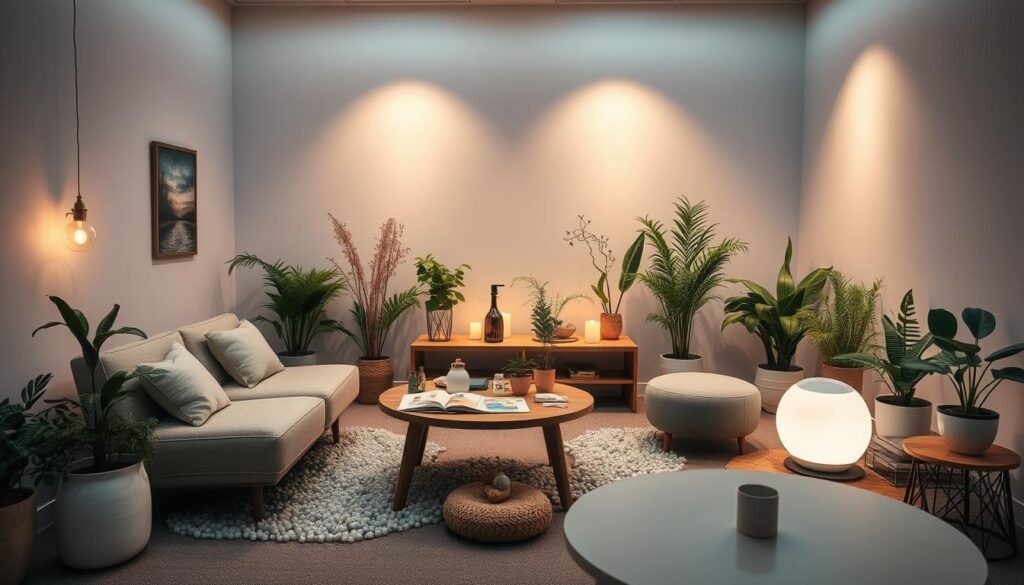
For seniors, especially those in assisted living, sensory activities offer great benefits. They can boost social interaction, mood, and sleep. About 70% of those with dementia feel better and show fewer behavior issues when doing these activities. Then, 60% of seniors in these settings do sensory activities weekly, helping them engage more with others.
“85% of caregivers reported that sensory activities for seniors helped them connect better with their loved ones,” according to a study.
Many occupational therapists now use sensory activities in their work. It’s effective, with 67% of them choosing these methods. Also, sensory rooms and tools like weighted blankets decrease stress, making a peaceful environment for users.
Adding these sensory-friendly activities into the lives of adults and the elderly significantly boosts their happiness and relaxation.
Scent Boxes for Memory Activation
Scent boxes are key in stirring up memories and feelings. They bring comfort and keep the brain active. This is really important for older people, especially those who have trouble with their senses. Using sensory activities helps improve their life and helps them connect with others.
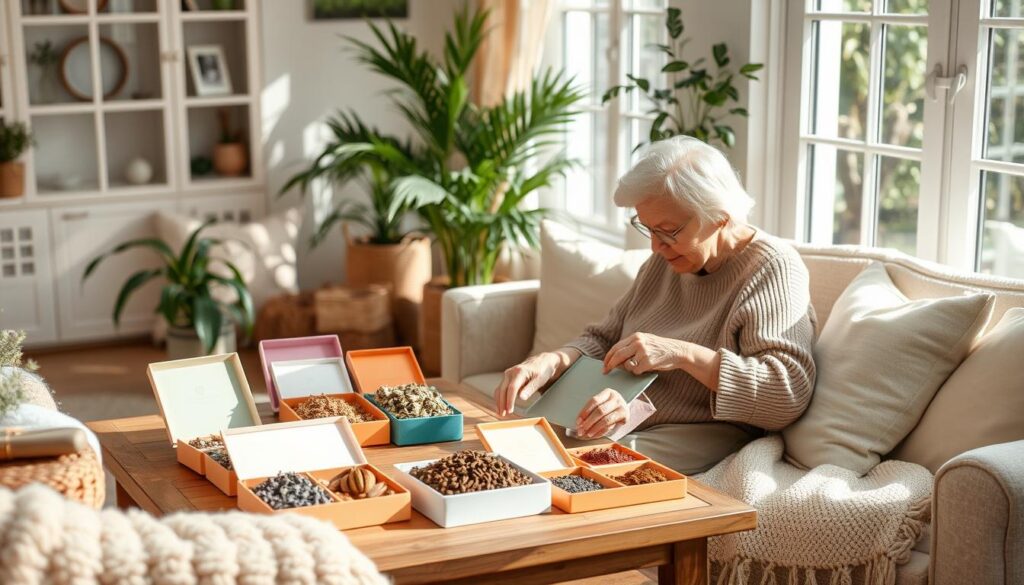
How to Create Scent Boxes
To build a good scent box, pick smells that mean something special to the person. Use oils like lavender, lemon, and eucalyptus because they’re calming. Here’s how to create a scent box:
- Choose oils or herbs that remind you of something important.
- Put them in small, sturdy containers.
- Mark each container with the name of the scent for easy finding.
- Add both well-known and new smells to keep things interesting.
Doing this makes sure activities for older adults are fun and meaningful. It helps bring back important memories.
Using Essential Oils Safely
Essential oils are great but must be used carefully, especially with dementia patients. Here are some tips for safety:
- Dilution: Always mix essential oils with a carrier oil to avoid skin problems.
- Allergies: Test on a small skin area first to check for allergies.
- Ventilation: Keep the area airy so the strong smells don’t become too much.
- Supervision: Always watch over when using scent boxes with those who have cognitive issues.
Following these safety tips makes using essential oils a positive part of daily care. It boosts mental and emotional health.
Benefits of Wooden Puzzles for Elderly
Wooden puzzles provide many benefits for older adults, especially those with dementia or cognitive problems. They’re not just for fun; they’re key for tactile stimulation for dementia. Working with these puzzles helps improve hand-eye coordination. This is vital for seniors facing issues with their dexterity.
A study with 76 older people with mild cognitive issues showed clear cognitive improvements. Their scores went up after they used the puzzles. Plus, their depression symptoms lessened. This points to the mental and emotional perks of puzzles.
The same study found that these activities boosted participants’ feelings of competence and connection. This is big for their mental health and for staying socially active. Wood puzzles, with their large, easy-to-grab pieces, are perfect for the elderly. They offer tactile stimulation for dementia and keep the mind engaged.
But the benefits don’t stop at just keeping the mind sharp. Puzzles also help foster a sense of achievement and self-esteem. This is key for the mental health of seniors. Puzzles provide a complete approach to elderly care. They mix brain exercise with emotional support.
Making Sensory Pouches/Squish Bags
Making sensory pouches or squish bags is easy and fun. They are great for touch and sight, helping adults with disabilities. You can use things you already have, so they’re cheap and easy to make.
Materials Needed for Sensory Pouches
To make good sensory pouches, you need the right stuff. Here’s what you should gather:
- Strong ziplock bags (preferably freezer strength to avoid leaks)
- Hair gel (clear or colored)
- Food coloring (optional for added visual stimulation)
- Small toys or objects (such as buttons, beads, or glitter)
- Duct tape (for sealing the edges securely)
Step-by-Step Guide to Making Squish Bags
Here’s how to make your own sensory pouches:
- Prepare the Bag: Open a ziplock bag and fill it with a lot of hair gel. Add some food coloring if you want color.
- Add Objects: Put in small toys, buttons, or beads. They add cool textures and things to look at.
- Seal the Bag: Get rid of extra air and seal the bag. Use duct tape on the edges to avoid leaks.
- Test for Durability: Press and squeeze the bag gently. This is to make sure it won’t leak.
These sensory pouches are simple and fast to put together. They’re perfect for different sensory activities for adults with disabilities. DIY sensory bags are a fun way to relax, focus better, and wake up the senses. They create a peaceful and helpful experience for everyone.
Bringing a Day at the Beach Indoors
Outdoor activities become tricky with extreme summer heat. So, finding fun indoor activities is key. Creating an indoor beach experience helps elderly people feel joy and get many benefits. Using sand, water, and shells, with sounds of waves, brings back good memories. This gives a calming effect through seeing, touching, and hearing.
When the thermometer hits 90°F or above, families look for indoor fun. A 72% jump in searches for indoor beach activities during hot days shows this trend. For older people, simulating a beach setting can feel soothing and bring back special memories.
To make an indoor beach, start with a sensory area using a sandbox filled with fine sand. Include shells, small rocks, and water beads that grow bigger in water for a fun touch. Background sounds of waves and seagulls make everything feel real. These activities create a peaceful indoor getaway. They also awaken different senses, making staying inside fun and calming.

